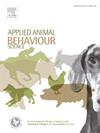A keypoint detection-based approach for real-time aggressive behavior identification in goats
IF 2
2区 农林科学
Q1 AGRICULTURE, DAIRY & ANIMAL SCIENCE
引用次数: 0
Abstract
This study addresses the existing challenges in animal aggression behavior detection by proposing a real-time recognition method based on keypoint detection. Traditional detection methods based on static whole-frame images are limited in their ability to analyze dynamic processes, often leading to false positives, where non-aggressive behaviors are misclassified as aggression. While algorithms incorporating Long Short-Term Memory (LSTM) networks improve accuracy, they suffer from poor real-time performance due to the need for comprehensive analysis of sequential video data, resulting in a high computational burden and an inability to pinpoint specific aggression events. Furthermore, many existing approaches require artificial interventions during the data collection phase, such as increasing animal density to provoke aggression, which can induce stress responses in the animals and generate data that deviate from natural behaviors, thus failing to accurately reflect authentic social interactions and conflict mechanisms. To overcome these challenges, this study introduces a novel method that detects keypoints on the head and body of goats, analyzing the movement relationships between these keypoints in real-time to identify aggressive behavior without the need for artificial intervention. Experimental results demonstrate that this approach outperforms existing methods in terms of accuracy, recall rate, and false positive rate, while offering superior real-time performance and robustness. Moreover, the proposed method is highly extensible, not only applicable to aggression detection but also capable of analyzing other daily behaviors of goats through keypoint data. To contribute to the advancement of the field of animal behavior studies, we have made publicly available a dataset containing keypoint information of goats, providing valuable resources for future research.
基于关键点检测的山羊攻击行为实时识别方法
针对目前动物攻击行为检测存在的问题,提出了一种基于关键点检测的实时识别方法。基于静态全帧图像的传统检测方法在分析动态过程的能力上受到限制,经常导致误报,其中非攻击行为被错误地归类为攻击。虽然结合长短期记忆(LSTM)网络的算法提高了准确性,但由于需要对连续视频数据进行全面分析,它们的实时性较差,导致计算负担高,无法精确定位特定的攻击事件。此外,许多现有的方法需要在数据收集阶段进行人工干预,例如增加动物密度以引发攻击,这可能导致动物的应激反应,产生偏离自然行为的数据,从而无法准确反映真实的社会互动和冲突机制。为了克服这些挑战,本研究引入了一种检测山羊头部和身体关键点的新方法,实时分析这些关键点之间的运动关系,以识别攻击行为,而无需人工干预。实验结果表明,该方法在准确率、查全率和误报率方面均优于现有方法,同时具有较好的实时性和鲁棒性。此外,该方法具有很强的可扩展性,不仅适用于攻击检测,还可以通过关键点数据分析山羊的其他日常行为。为了促进动物行为研究领域的发展,我们公开了一个包含山羊关键点信息的数据集,为未来的研究提供宝贵的资源。
本文章由计算机程序翻译,如有差异,请以英文原文为准。
求助全文
约1分钟内获得全文
求助全文
来源期刊

Applied Animal Behaviour Science
农林科学-行为科学
CiteScore
4.40
自引率
21.70%
发文量
191
审稿时长
18.1 weeks
期刊介绍:
This journal publishes relevant information on the behaviour of domesticated and utilized animals.
Topics covered include:
-Behaviour of farm, zoo and laboratory animals in relation to animal management and welfare
-Behaviour of companion animals in relation to behavioural problems, for example, in relation to the training of dogs for different purposes, in relation to behavioural problems
-Studies of the behaviour of wild animals when these studies are relevant from an applied perspective, for example in relation to wildlife management, pest management or nature conservation
-Methodological studies within relevant fields
The principal subjects are farm, companion and laboratory animals, including, of course, poultry. The journal also deals with the following animal subjects:
-Those involved in any farming system, e.g. deer, rabbits and fur-bearing animals
-Those in ANY form of confinement, e.g. zoos, safari parks and other forms of display
-Feral animals, and any animal species which impinge on farming operations, e.g. as causes of loss or damage
-Species used for hunting, recreation etc. may also be considered as acceptable subjects in some instances
-Laboratory animals, if the material relates to their behavioural requirements
 求助内容:
求助内容: 应助结果提醒方式:
应助结果提醒方式:


